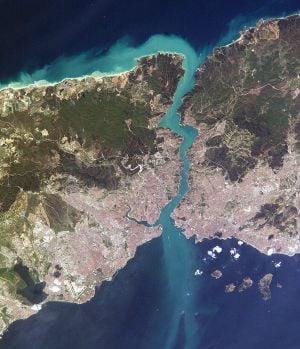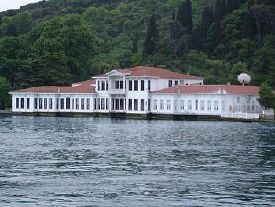Bosporus
The Bosporus or Bosphorus, also known as the Istanbul Strait, (Turkish: İstanbul Boğazı) (Greek: Βόσπορος) is a strait that forms the boundary between the European part (Thrace) of Turkey and its Asian part (Anatolia). The world's narrowest strait used for international navigation, it connects the Black Sea with the Sea of Marmara (which is connected by the Dardanelles to the Aegean Sea, and thereby to the Mediterranean Sea). It is approximately 30 km long, with a maximum width of 3,700 metres at the northern entrance, and a minimum width of 700 metres between Kandilli and Aşiyan; and 750 metres between Anadoluhisarı and Rumelihisarı. The depth varies from 36 to 124 metres in midstream. The shores of the strait are heavily populated as the city of Istanbul (with a metropolitan area in excess of 11 million inhabitants) straddles it.
Two bridges cross the Bosporus. The first, the Bosphorus Bridge, is 1074 metres long and was completed in 1973. The second, Fatih Sultan Mehmet (Bosphorus II) Bridge, is 1090 metres long, and was completed in 1988 about five kilometres north of the first bridge. Plans for a third road bridge, which will allow transit traffic to by-pass the city traffic, have been approved by the Ministry of Transportation. The bridge will be part of the "Northern Marmara Motorway", which will be further integrated with the existing Black Sea Coastal Highway. The location will be somewhere north of the existing two bridges, but the exact path is kept secret to avoid an early boom in land prices.
Another crossing, Marmaray, is a 13.7 kilometre-long undersea railway tunnel currently under construction and is expected to be completed in 2012. Approximately 1,400 metres of the tunnel will run under the strait, at a depth of about 55 metres.
Associations
The name Bosporus comes from the Greek word Bosporos (Βόσπορος).[1] Its etymology is from bous (βοῦς: ox) and poros (πόρος: means of passing a river, ford, ferry)[2] (the similar Ancient Greek word for passage, strait is porthmos (πορθμός)[3]), thus meaning "oxen passage", which could reflect the older history of the region. The Greeks analysed it as "ox-ford" or "shallow sea ox passage"[1] and associated it with the myth of Io's travels after Zeus turned her into a heifer for her protection.[4] It has also been thought to be a Thracian form of Phôsphoros (Φωσφόρος), 'light-bearing', an epithet of the goddess Hecate.
It is also said in myth that floating rocks known as the Symplegades, or Clashing Rocks, once crushed any ship that attempted passage of the Bosporus until the hero Jason obtained passage, whereupon the rocks became fixed, and Greek access to the Black Sea was opened.
Formation of the Bosporus
The exact cause for the formation of the Bosporus remains the subject of vigorous debate among geologists. Thousands of years ago, the Black Sea became disconnected from the Aegean Sea. One recent theory (published in 1997 by William Ryan and Walter Pitman from Columbia University) contends that the Bosporus was formed about 5600 B.C.E. when the rising waters of the Mediterranean/Sea of Marmara breached through to the Black Sea, which at the time (according to the theory) was a low-lying body of fresh water.
Some have argued[citation needed] that the resulting massive flooding of the inhabited and probably farmed northern shores of the Black Sea is thought to be the historic basis for the flood stories found in the Epic of Gilgamesh and in the Bible in Book of Genesis, Chapters 6-9. On the other hand, there is also evidence for a flood of water going in the opposite direction, from the Black Sea into the Sea of Marmara[citation needed] around 7000 or 8000 B.C.E.
Biblical reference
St. Jerome's Vulgate translates the Hebrew besepharad in Obadiah, 1-20 as "Bosforus", but other translations give it as "Sepharad" (probably Sardis, but later identified with Spain).[5]
Ancient Greece, Rome, the Byzantines and the Ottoman Empire
As the only passage between the Black Sea and the Mediterranean, the Bosporus has always been of great commercial and strategic importance. The Greek city-state of Athens in the 5th century B.C.E., which was dependent on grain imports from Scythia, therefore maintained critical alliances with cities which controlled the straits, such as the Megarian colony Byzantium.
The strategic significance of the strait was one of the factors in the decision of the Roman Emperor Constantine the Great to found there in 330 C.E. his new capital, Constantinople, which came to be known as the capital of the Eastern Roman Empire. On May 29, 1453 it was conquered by the emerging Ottoman Empire. In fact, as the Ottoman Turks closed in on Constantinople, they constructed a fortification on each side of the strait, Anadoluhisarı (1393) and Rumelihisarı (1451). They later renamed the city Istanbul.
Strategic importance
The strategic importance of the Bosporus remains high, and control over it has been an objective of a number of hostilities in modern history, notably the Russo–Turkish War, 1877–1878, as well as of the attack of the Allied Powers on the Dardanelles in 1915 in the course of World War I.
Several international treaties have governed vessels using the waters. Following WW I, the 1920 Treaty of Sèvres demilitarized the strait and made it an international territory under the control of the League of Nations. This was amended under the 1923 Treaty of Lausanne, which restored the straits to Turkish territory –but allowed all foreign warships and commercial shipping to traverse the straits freely. Turkey eventually rejected the terms of that treaty, and subsequently Turkey remilitarized the straits area. The reversion to this old regime was formalized under the Montreux Convention Regarding the Regime of the Turkish Straits of July 1936. That convention, which is still in practical force as of 2008, treats the straits as an international shipping lane, but Turkey does retain the right to restrict the naval traffic of non-Black Sea nations (such as Greece, a traditional enemy, or Algeria).
During World War II, through February 1945, when Turkey was neutral for most of the length of the conflict, the Dardanelles were closed to the ships of the belligerent nations. In the conferences during World War II, Soviet leader Joseph Stalin openly requested the concession of Soviet military bases on the Straits, even though Turkey was not involved in the war. This incident, coupled with Stalin's demands for the restitution of the Turkish provinces of Kars, Artvin and Ardahan to the Soviet Union (which were lost by Turkey with the Russo–Turkish War of 1877–1878, but were regained with the Treaty of Kars in 1921) was one of the main reasons why Turkey decided to give up its general principle of neutrality in foreign affairs. Turkey did declare war against Germany in February 1945, but did not engage in offensive actions.
Turkish troops fought on behalf of the United Nations during the Korean War in 1950-53. Turkey joined NATO in 1952.[6][7][8][9] In more recent years, the Turkish Straits have become particularly important for the oil industry. Russian oil, from ports such as Novorossyisk, is exported by tankers to western Europe and the U.S. via the Bosphorus and the Dardanelles straits.
Sightseeing
A cheap way to explore the Bosporus is offered by the public ferries that traverse the Bosporus from Eminönü on the historic peninsula of Istanbul to Anadolu Kavağı near the Black Sea, zigzagging between the Rumelian and Anatolian sides of the city.[10]
It is also possible to experience Bosphorus by taking a regular ride in one of the public ferries that travel in every 45 minutes between the European and the Asian sides. It is also possible to travel by the privately owned ferries available between Üsküdar and Beşiktaş.
There are also touristic rides available in various places along the coasts of Bosphorus. The prices vary according to the type of the ride, and some feature loud popular music for the duration of the trip.
See also
- List of maritime incidents in the Turkish Straits
- Dardanelles
- Turkish Straits
Notes
- ↑ 1.0 1.1 Liddell, Henry George, Robert Scott, Henry Stuart Jones, and Roderick McKenzie. 1996. A Greek-English lexicon. Oxford: Clarendon Press. ISBN 9780198642237 Βόσπορος online version from Tufts University Perseus Project
- ↑ Liddell, Henry George, Robert Scott, Henry Stuart Jones, and Roderick McKenzie. 1996. A Greek-English lexicon. Oxford: Clarendon Press. ISBN 9780198642237 πόρος online version from Tufts University Perseus Project
- ↑ Liddell, Henry George, Robert Scott, Henry Stuart Jones, and Roderick McKenzie. 1996. A Greek-English lexicon. Oxford: Clarendon Press. ISBN 9780198642237 πορθμός online version from Tufts University Perseus Project
- ↑ Aeschylus. Prometheus Bound. 733.
- ↑ Obadiah, 1-20.
- ↑ Foreign Policy Research Institute: The Turkish Factor in the Geopolitics of the Post-Soviet Space (Igor Torbakov)
- ↑ Robert Cutler: Turkish-Soviet Relations
- ↑ Answers.com: Russia's relations with Turkey
- ↑ Today's Zaman: Against who and where are we going to stand? (Ali Bulaç)
- ↑ Explore Bosphorus with IDO, on the website of İDO.
ReferencesISBN links support NWE through referral fees
- Cleveland, Cutler J. August 23, 2008. Bosporus Straits, Turkey Encyclopedia of Earth. Retrieved December 19, 2008.
- Kuzma, Greg. 1971. The Bosporus. Belmont, Mass: Hellric Publications]. ISBN 9780912086057
- Phillipson, Coleman, and Noel Noel-Buxton Noel-Buxton. 1917. The question of the Bosphorus and Dardanelles. London: Stevens and Haynes. OCLC 1112029
- Shotwell, James Thomson, and Francis Deák. 1940. Turkey at the Straits; a short history. New York: Macmillan Co. OCLC 397166
External links
All Links Retrieved December 19, 2008.
- TulpArt-Anatolia's Eye. High Resolution Pictures of Bosphorus
- Google Maps link to Bosphorus
Coordinates:
Credits
New World Encyclopedia writers and editors rewrote and completed the Wikipedia article in accordance with New World Encyclopedia standards. This article abides by terms of the Creative Commons CC-by-sa 3.0 License (CC-by-sa), which may be used and disseminated with proper attribution. Credit is due under the terms of this license that can reference both the New World Encyclopedia contributors and the selfless volunteer contributors of the Wikimedia Foundation. To cite this article click here for a list of acceptable citing formats.The history of earlier contributions by wikipedians is accessible to researchers here:
The history of this article since it was imported to New World Encyclopedia:
Note: Some restrictions may apply to use of individual images which are separately licensed.









